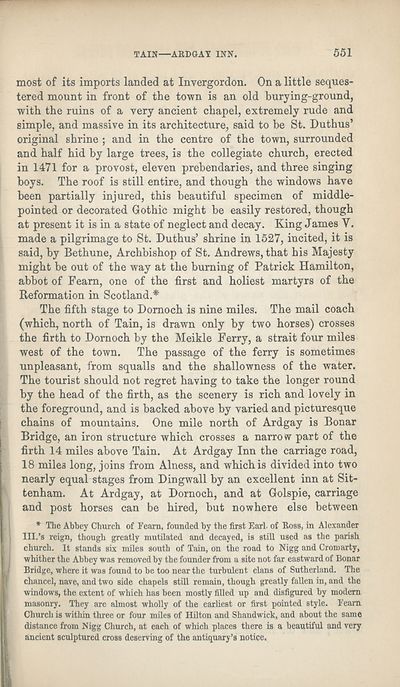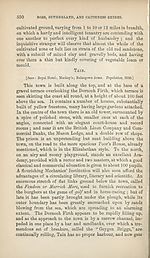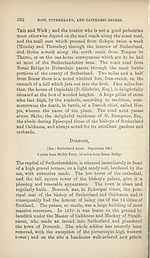Download files
Complete book:
Individual page:
Thumbnail gallery: Grid view | List view

?—ARDGAY INN.
551
most of its imports landed at Invergorden. On a little seques¬
tered mount in front of the town is an old burying-ground,
with the ruins of a very ancient chapel, extremely rude and
simple, and massive in its architecture, said to be St. Duthus’
original shrine ; and in the centre of the town, surrounded
and half hid by large trees, is the collegiate church, erected
in 1471 for a provost, eleven prebendaries, and three singing
boys. The roof is still entire, and though the windows have
been partially injured, this beautiful specimen of middle-
pointed or decorated Gothic might be easily restored, though
at present it is in a state of neglect and decay. King James Y.
made a pilgrimage to St. Duthus’ shrine in 1527, incited, it is
said, by Bethune, Archbishop of St. Andrews, that his Majesty
might be out of the way at the burning of Patrick Hamilton,
abbot of Feam, one of the first and holiest martyrs of the
Reformation in Scotland.*
The fifth stage to Dornoch is nine miles. The mail coach
(which, north of Tain, is drawn only by two horses) crosses
the firth to Dornoch by the Meikle Ferry, a strait four miles
west of the town. The passage of the ferry is sometimes
unpleasant, from squalls and the shallowness of the water.
The tourist should not regret having to take the longer round
by the head of the firth, as the scenery is rich and lovely in
the foreground, and is backed above by varied and picturesque
chains of mountains. One mile north of Ardgay is Bonar
Bridge, an iron structure which crosses a narrow part of the
firth 14 miles above Tain. At Ardgay Inn the carriage road,
18 miles long, joins from Alness, and which is divided into two
nearly equal stages from Dingwall by an excellent inn at Sit-
tenham. At Ardgay, at Dornoch, and at Golspie, carriage
and post horses can be hired, but nowhere else between
* The Abbey Cburch of ream, founded by the first Earl, of Ross, in Alexander
III.’s reign, though greatly mutilated and decayed, is still used as the parish
church. It stands six miles south of Tain, on the road to Nigg and Cromarty,
whither the Abbey was removed by the founder from a site not far eastward of Bonar
Bridge, where it was found to be too near the turbulent clans of Sutherland. The
chancel, nave, and two side chapels still remain, though greatly fallen in, and the
windows, the extent of which has been mostly filled up and disfigured by modem
masonry. They are almost wholly of the earliest or first pointed style. Beam
Church is within three or four miles of Hilton and Shandwick, and about the same
distance from Nigg Church, at each of which places there is a beautiful and very
ancient sculptured cross deserving of the antiquary’s notice.
551
most of its imports landed at Invergorden. On a little seques¬
tered mount in front of the town is an old burying-ground,
with the ruins of a very ancient chapel, extremely rude and
simple, and massive in its architecture, said to be St. Duthus’
original shrine ; and in the centre of the town, surrounded
and half hid by large trees, is the collegiate church, erected
in 1471 for a provost, eleven prebendaries, and three singing
boys. The roof is still entire, and though the windows have
been partially injured, this beautiful specimen of middle-
pointed or decorated Gothic might be easily restored, though
at present it is in a state of neglect and decay. King James Y.
made a pilgrimage to St. Duthus’ shrine in 1527, incited, it is
said, by Bethune, Archbishop of St. Andrews, that his Majesty
might be out of the way at the burning of Patrick Hamilton,
abbot of Feam, one of the first and holiest martyrs of the
Reformation in Scotland.*
The fifth stage to Dornoch is nine miles. The mail coach
(which, north of Tain, is drawn only by two horses) crosses
the firth to Dornoch by the Meikle Ferry, a strait four miles
west of the town. The passage of the ferry is sometimes
unpleasant, from squalls and the shallowness of the water.
The tourist should not regret having to take the longer round
by the head of the firth, as the scenery is rich and lovely in
the foreground, and is backed above by varied and picturesque
chains of mountains. One mile north of Ardgay is Bonar
Bridge, an iron structure which crosses a narrow part of the
firth 14 miles above Tain. At Ardgay Inn the carriage road,
18 miles long, joins from Alness, and which is divided into two
nearly equal stages from Dingwall by an excellent inn at Sit-
tenham. At Ardgay, at Dornoch, and at Golspie, carriage
and post horses can be hired, but nowhere else between
* The Abbey Cburch of ream, founded by the first Earl, of Ross, in Alexander
III.’s reign, though greatly mutilated and decayed, is still used as the parish
church. It stands six miles south of Tain, on the road to Nigg and Cromarty,
whither the Abbey was removed by the founder from a site not far eastward of Bonar
Bridge, where it was found to be too near the turbulent clans of Sutherland. The
chancel, nave, and two side chapels still remain, though greatly fallen in, and the
windows, the extent of which has been mostly filled up and disfigured by modem
masonry. They are almost wholly of the earliest or first pointed style. Beam
Church is within three or four miles of Hilton and Shandwick, and about the same
distance from Nigg Church, at each of which places there is a beautiful and very
ancient sculptured cross deserving of the antiquary’s notice.
Set display mode to:
![]() Universal Viewer |
Universal Viewer | ![]() Mirador |
Large image | Transcription
Mirador |
Large image | Transcription
| Antiquarian books of Scotland > Scotland/Scots > Black's picturesque tourist of Scotland > (685) |
|---|
| Permanent URL | https://digital.nls.uk/130036410 |
|---|
| Description | Thousands of printed books from the Antiquarian Books of Scotland collection which dates from 1641 to the 1980s. The collection consists of 14,800 books which were published in Scotland or have a Scottish connection, e.g. through the author, printer or owner. Subjects covered include sport, education, diseases, adventure, occupations, Jacobites, politics and religion. Among the 29 languages represented are English, Gaelic, Italian, French, Russian and Swedish. |
|---|

